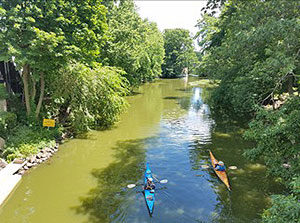
This is what we don’t want the Mystic River to look like. — Photo by Jack Bitney
(The opinions and views expressed in the commentaries and letters to the Editor of The Somerville Times belong solely to the authors and do not reflect the views or opinions of The Somerville Times, its staff or publishers.)
Here is a picture of a cyanobacteria and algae “bloom”– or population explosion – turning the Mystic pea-soup green in the summer of 2017.Multiple factors contributed to the bloom event – temperature, rainfall rates. But the fundamental underlying cause was nutrient pollution, especially excess phosphorus.
Thinking about nutrients as pollutants takes some getting used to. After all, phosphorus and nitrogen are necessary building blocks of life. We need them. Plants need them.
In fact, plants love them!
And that can be the problem. Too many nutrients in an aquatic ecosystem can lead to really bad outcomes. The most famous example is perhaps the annual dead zone in the Gulf of Mexico every year.
The Gulf receives fertilizer runoff from the vast agricultural watershed of the Mississippi River. Spring and summer bring huge algae blooms in the Gulf, fueled by fertilizer. When those blooms die, organisms that decompose the algae use up all the dissolved oxygen in the water. Fish and other animals that can move retreat. The rest die. A huge area is affected. Scientists expect an especially bad summer this year.
In the Great Lakes and many other places, nutrient pollution causes blooms of cyanobacteria, like the one in the Mystic. Cyanobacteria can produce toxins that harm public health. The City of Toledo has shut down its water supply because of cyanobacteria in Lake Erie. This week officials urged residents to avoid Lake Pontchartrain in Louisiana for the same reason. Flooding in the Midwest this spring has vastly increased the likelihood.
Urban areas contribute high levels of phosphorus. This is a little counterintuitive, but there are good explanations for this. As a result, the Massachusetts Department of Environmental Protection labels the Mystic River and other water bodies in the watershed officially “impaired” by phosphorus. We have not only cyanobacteria blooms like the one in 2017, but huge infestations of invasive plants, habitat degradation, and more – all stemming from excess nutrients.
At MyRWA, we have been engaged in a 5-year project to model the amount of phosphorus entering the Mystic system and to understand its effects. It’s a collaboration that has drawn on the financial support and technical contributions of many partners including the US Environmental Protection Agency (EPA), Mass Dept. of Environmental Protection (DEP), United States Geologic Survey (USGS), Massachusetts Water Resources Authority (MWRA), and others. Our collaboration will lead to a scientific report that will quantify how much phosphorus inputs have to be reduced to meet water quality standards.
At MyRWA, we are also just wrapping up the first of a multi-year municipal education effort on nutrient pollution, the year funded by the Massachusetts Environmental Trust.
We have given public talks; held one-on-one presentations to municipal officials, including mayors; created tabling displays on stormwater and nutrient pollution; and brought a curriculum on stormwater to several local municipalities’ classrooms through our new environmental education program.
Cost-effective solutions are at hand, and we will continue to spread the word about them. From improved street sweeping regimes, to green infrastructure installations (rain gardens, stormwater wetlands), cities and towns can improve infrastructure in a way that reduces nutrient pollution, beautifies the built environment, and begins to restore the ecological functions of our rivers, lakes and streams.
Stormwater wetland at Alewife Reservation, Cambridge. Plants and soils absorb phosphorus from runoff, before it can get to the river.
About the Mystic River Watershed Association:
The Mystic River Watershed Association works every day to protect our water, restore important habitat, transform our parks and paths, build climate resilience, and inspire youth and community members. This benefits the more than half million residents throughout the 76 square mile watershed
For more information, see www.MysticRiver.org.
— Mystic River Watershed Association












I grew up in the mystic ave projects, went to the grimmons school, spent a lot of time around the mystic river. My father told me stories of the Somerville beach, how he and a lot of kids jumped off the Wellington bridge and swam in that river. I know where the bath house was and the soap factory, care to guess where all the crap from both went??? We had a saying growing up, “don’t fall in, you will glow in the dark” it was a joke then, not any more.
“Love that dirty water, Boston your my home”